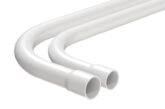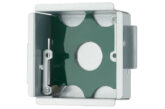
Steve Humphreys, Technical Commercial Manager at NAPIT, analyses the installation of cables within containment systems.
How often have we lifted a lid off a run of trunking to reveal that it is jam-packed with cables with no consideration for its capacity or spacing factors? Fig 1 shows some cables which are poorly contained.
It is quite common for circuits to be added after the initial installation and it is the responsibility of designers and installers to ensure that the containment system is still large enough to accommodate these additional cables.
It is essential for an initial installation that the designer selects trunking and conduit systems that are sized correctly so they can comfortably accommodate the number of circuit conductors required. Failure to do so can result in damage to conductor insulation, especially when drawing the cables into the containment system.
Another issue is that there will be an increase in operational temperature when too many cables are installed in trunking or conduit.
Common sense tells us that the more cables we have in a containment system, the more heat is generated, which in turn reduces the current carrying capacity of the conductors. Therefore, it is extremely important to leave free space, known as a ‘spacing factor’ within the containment system to allow any excess heat to dissipate.
In this article, we will look at the requirements of BS 7671 as well as other guidance documents which designers can use to calculate the correct number of cables that can be installed in trunking and conduit systems.
What does BS 7671 say?
The capacities of conduit and trunking have not been included in BS 7671 since 1991, as the information was considered by the committee to be guidance. However, BS 7671:2018+A3:2024 does provide relevant recommendations in Appendix 4.
This appendix discusses the current carrying capacities of conductors taking into account factors such as:
- Installation methods
- Rating factors
- Ambient temperature
- Cables grouped in conduit and trunking systems
Appendix 4 of BS 7671 is basically the designers’ ‘go to’ guide for cable design as well as identifying the cross-sectional area of conductors.
Once we’ve established the type, size and number of circuit conductors to be installed, we now need to turn to further guidance to select an appropriately sized trunking or conduit.
Further guidance
Fortunately, the IET On-Site Guide Appendix E contains more information regarding cable capacities for trunking and conduit.
It is worth pointing out that this is guidance only and is concerned with the maximum number of cables that should be drawn in, so does not consider factors such as grouping as mentioned earlier in Appendix 4 of BS 7671. The use of this guidance should ensure that the cables can be drawn in easily and with the least risk of damage to them.
The guidance deals with single-core thermoplastic (PVC) insulated cables in the following containment systems:
- Straight runs of conduit not exceeding 3 m in length
- Straight runs of conduit exceeding 3 m in length
- Runs of conduit of any length and/or that incorporate bends or sets
- Trunking
The IET On-Site Guide contains a set of tables (E1 to E6) that assist in the selection of conduit and trunking. These tables provide allocated factors for conduit and trunking.
Conduit worked example
Let’s assume we need to install two radial circuits within a metal conduit. Each of the circuits are single phase, thermoplastic single-core cables with a 4 mm² cross-sectional area.
This means in total we have 6 x 4 mm2 conductors. Let’s also assume that the conduit run is 5 metres in length and incorporates two bends. How do we work out the required diameter of conduit?
Firstly, we look at Table 1 to work out the cable factor. We can see that 4 mm² conductors have a cable factor of 43. As we have six conductors, we need to multiply the number of conductors by the cable factor.
6 x 43 = 258
Therefore, our total cable factor for the two radial circuits is 258.
Next, we need to look at Table 2 which will give us a conduit factor. In our worked example, with a conduit 5 metres in length and incorporating two bends, we are looking for a factor that is greater than or equal to our total cable factor of 258.
From Table 2, we can see a 5 metre run with two bends and there are only two choices of conduit diameter – 25 mm or 32 mm. The conduit factor equal to or greater than our total cable factor of 258 is 358. This gives us a conduit diameter of 25 mm.
So we can see that a 25 mm conduit will ensure that our two radial circuits can be drawn in easily with a low risk of damage to the cables. For cables and/or conduits not covered by these tables, the designer or installer should seek advice from the manufacturer on the number of cables that can be drawn in.
Trunking worked example
Let’s assume we need to install the following single phase circuits that are wired with thermoplastic (PVC) single-core stranded cables within a trunking system:
- 4 x radial lighting circuits with a 1.5 mm² cross-sectional area
- 4 x ring final circuits with a 2.5 mm² cross-sectional area
- 2 x radial EV charge point circuits with a 6.0 mm² cross-sectional area
- 3 x radial electric heater circuits with a 4.0 mm² cross-sectional area
How do we work out the required size of the trunking?
Firstly, we look at Table 3 to work out the cable factors. It is evident from the example that we are using four different conductor sizes, as well as multiple circuits.
We need to work out the cable factor for each conductor first:
- 1.5 mm² cross-sectional area has a cable factor of 8.6
- 2.5 mm² cross-sectional area has a cable factor of 12.6
- 4.0 mm² cross-sectional area has a cable factor of 16.6
- 6.0 mm² cross-sectional area has a cable factor of 21.2
Next, we need to multiply these cable factors by the number of conductors:
- 4 x radial lighting circuits with 12 conductors x 8.6 = 103.2
- 4 x ring final circuits with 24 conductors x 12.6 = 302.4
- 2 x radial electric vehicle charge point circuits with 6 conductors x 21.2 = 127.2
- 3 x radial electric heater circuits with 9 conductors x 16.6 = 149.4
To get the total cable factor, simply add these together:
103.2 + 302.4 + 127.2 + 149.4 = 682.2
Now we turn to Table 4 to find a trunking factor that is greater than or equal to our total cable factor of 682.2 and this gives us a few choices.
The trunking factor closest to our total cable factor of 682.2 is 738, which gives a trunking size of 75 mm x 25 mm.
The designer may choose to use a larger trunking depending on the specification, manufacturer and future use of the electrical installation. For cables and/or trunking not covered by these tables, the requirement is that a space factor of 45% must not be exceeded.
This means that not more than 45% of the space within the trunking must be occupied by cables, with 55% of free space, as shown in Fig 2.
Conclusion
Far too often we see containment systems, such as trunking and conduit, packed with cables way beyond their intended capacity.
As mentioned earlier, this ultimately can lead to the potential danger of damaged cables during their installation or through overheating of conductors.
Hopefully, this article has been useful in understanding the requirements of BS 7671 and other guidance documents for designers and installers to calculate the correct number of cables that can be installed in trunking and conduit systems.
For more information on NAPIT scheme registration, click here
Find more industry technical articles here














